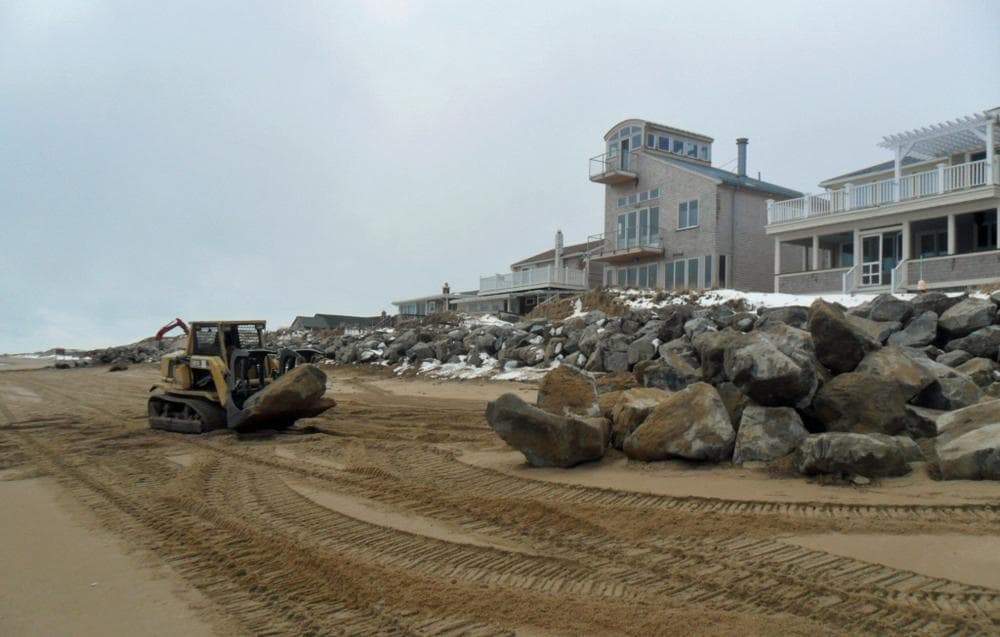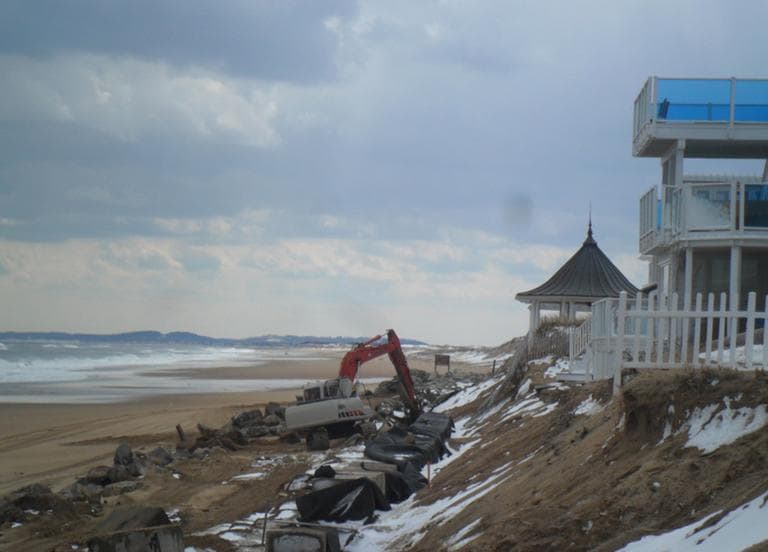Advertisement
Plum Island Homeowners Ignore State Regulations, Shore Up Homes
Resume
In the aftermath of a recent series of devastating winter storms, some Plum Island property owners are building giant barriers on the beach to protect their homes. State officials say their efforts, while understandable, are illegal.
Teresa Richey and her husband Mark live on the Plum Island beachfront. The price for an ocean view like theirs is steep, and the view a lot steeper since the most recent storm eroded more of the shoreline along this part of the island.
The Richeys moved into their new, custom-designed home just six days before the last nor'easter hit. The home is done in imported stone and exotic hardwoods.
"You can be sure that this house was built to the best," Teresa Richey said. "Whatever was the best thing available we did."
The house is just one of two on this part of the island built on steel beams driven 40-feet deep into the sand. There are three bedrooms, and every room in the house has an ocean view.

"Isn't it amazing? We see the sun rise from here. Every day is different, including today, we're seeing the bulldozers with all the rocks," she said.
Up and down the beach bulldozers and excavators work in tandem, digging deep trenches then filling them up with huge rocks or concrete cubes that look like giant, gray dice, and covering everything over with sand.
The process is called beach armoring. The giant rocks that form an artificial dune are called riprap. Armoring is expensive — $40,000 a home. In the aftermath of the storm, 10 shoreline Plum Island homeowners agreed to spend the money to protect their properties.
One contractor, who didn't want his name used, was working on one of the homes.
"Dunes behind the houses need to be somehow stabilized and secured. There are a couple of different ways people are doing it," he explained. "Some folks are going with the blocks of cement. We're doing it a little bit differently. We're using random shaped stone to best facilitate stability and drainage."
That's in theory. Greg Berman, a coastal process scientist with Woods Hole Oceanographic Institution, says in practice using riprap can make things worse because rocks reflect energy from waves.
"So when it bounces off it actually expends a lot more energy in a shorter space," Berman said. "There's a lot of turbulence in the water which can excavate out sand in front of that riprap and then it has the energy to transport it further offshore. So the overall lowering of the beach in front of riprap is, depending on the environment, fairly typical."
Whether armoring the beach on Plum Island will work is debatable. What's not open to discussion is that it's illegal here.
"Armoring of a dune, first of all, is not allowed in Massachusetts, it's also not allowed in virtually every other coastal state," said Ken Kimmell, commissioner of the Massachusetts Department of Environmental Protection.
Earlier this week, Kimmell sent Plum Island property owners a letter acknowledging their difficulties, but warning them that, ultimately, armoring their beach fronts will not prevent flooding during storms, or erosion.
"There's a lot of work that's going on on the beach right now and I did not want people to think that this was work we had in any way approved of," Kimmell said.
Kimmell warned Plum Island homeowners that they'll soon have to pay to remove the dune armor. But Richey isn't phased.
"I'd like to make a statement and be the first one in line to go to jail. And let's see what happens. They won't like me in jail, I'll drive them crazy," Richey said with a laugh. "I mean, I don't think that we've done anything to go to jail. Do you?"
The state has given property owners until the end of the storm season to take down their barriers. Otherwise there will be a showdown over the shoreline fortifications.
This article was originally published on March 22, 2013.
This program aired on March 22, 2013.
